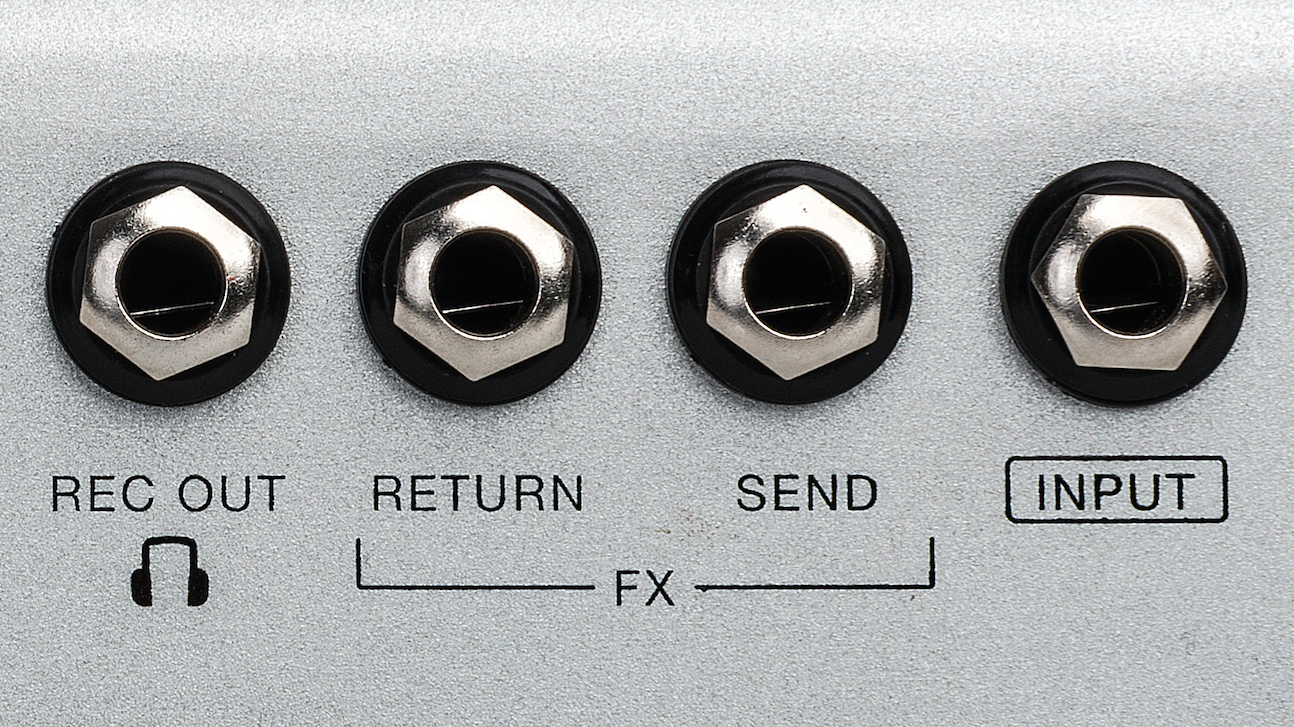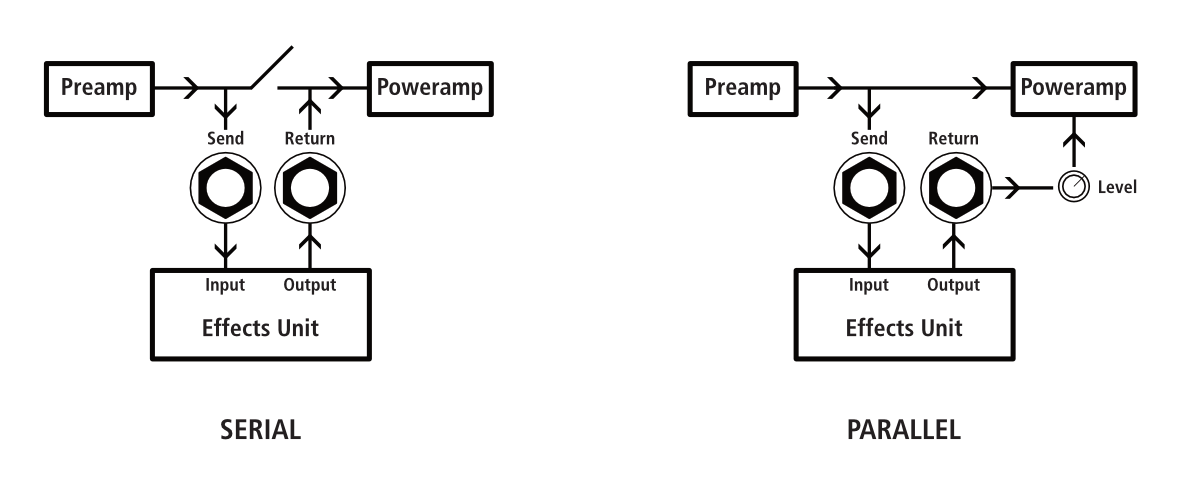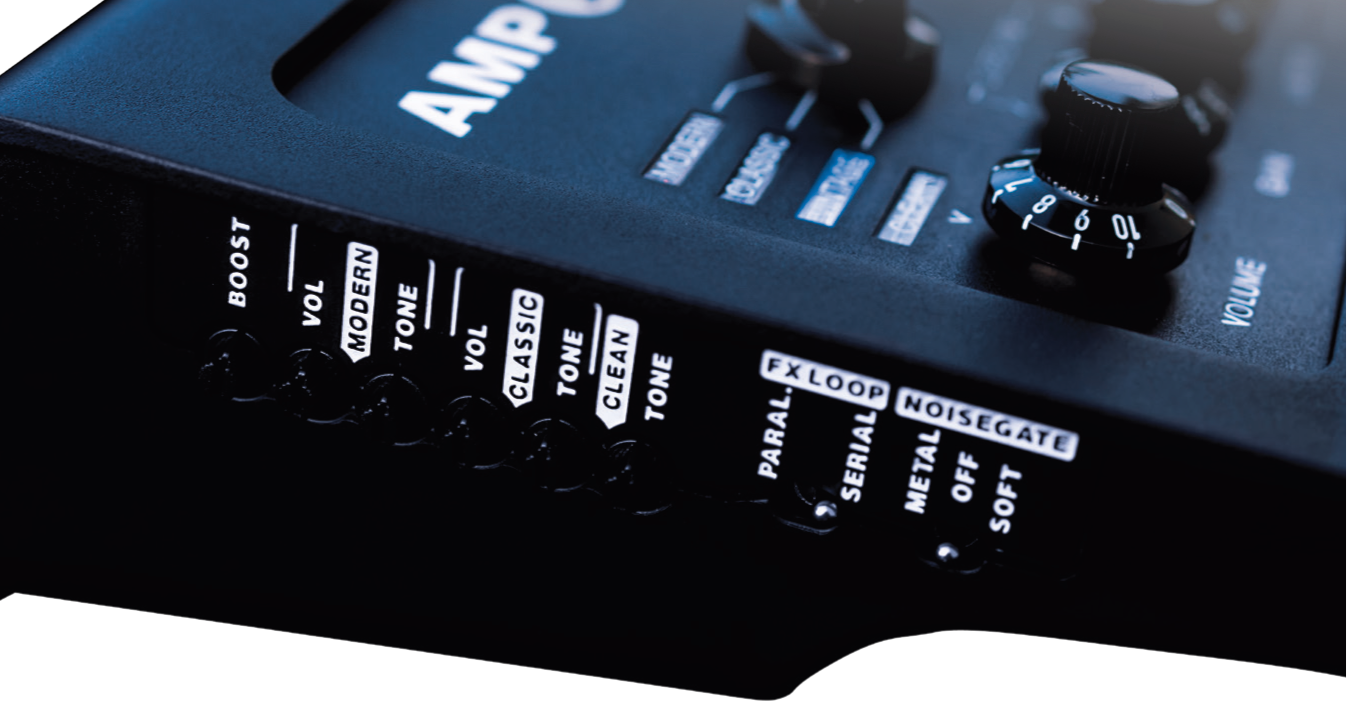Serial vs. parallel effects loop (FX loop)
What is an effects loop?
Guitar amps used to have no effect loops (FX loops), so all effects were connected before the input of the guitar amp. In the 1980s, some guitar amp manufacturers began adding effects to their amps with an insert loop placed after the preamp and before the power amp. At this point in the signal chain, the effects sound much cleaner - comparable to post effects used in mixing in the recording studio.
The effects loop is a break between the preamp and power amp of an amp in the form of an output and an input jack. The output socket (often labeled FX SEND or LINE OUT) picks up the signal after the preamp, the input socket (often labeled FX RETURN or LINE IN) returns it before the power amp. If the two sockets remain unoccupied, the input signal of the guitar goes unaffected directly from the preamp to the power amp. By assigning the two sockets, the signal is routed out of the amp, runs through one (or more) device(s) integrated into the FX loop and is fed back in before the power amplifier. The above-mentioned interruption between the preamp and the power amp is therefore not permanent, but rather switchable, depending on whether the two sockets are occupied or not.

In front of the amp or in the loop?
Basically, one can say that effects that change the dynamics, such as compressors, boosters or distortion, belong in front of the amp. With some effects (e.g. chorus) it is a matter of taste whether they are switched before the preamp, where they sound "dirtier" with increasing preamp distortion, or whether they - typically 80s - are placed in the FX loop. Because in the FX loop, the effects sound much cleaner - comparable to post effects that are used when mixing in the recording studio. Time-based effects like delay and reverb are also typically placed in the FX loop. You can find more information on the subject here: Pre or post FX: which effects belong before the amp and which in the FX loop?
What does serial or parallel mean?
For a long time, guitar amps only had serial effects paths. A serial FX loop interrupts the signal path between the preamp and power amp and routes the signal through a device included in the FX loop (see above). In this case there is no direct connection between preamp and power amp - the complete signal runs through the effects loop.
As the name suggests, a parallel FX loop has two signal paths arranged in parallel: The first signal path is a direct, internal connection between the preamp and power amp. In parallel, the second route sends the preamp signal through the FX loop (and through an effects processor integrated into the loop) and then feeds it back to the power amp, where it is mixed with the direct, also known as "dry" signal.

Serial or parallel - which is better?
Simple question, complicated answer: "It depends..." When using high quality effects with a true bypass, the serial effects loop almost always does a good job. It becomes problematic when the looped-in effects device leads to sound losses - for example due to a generally inferior audio quality or - in the case of digital effects - due to bad converters or too high a latency. Because we remember: With the serial effects path, the signal goes 100% through the loop and through the integrated effects device. A bad effect device can ruin the high-end sound of a good amp - and not only when it's switched on. Because the serial FX loop is activated as soon as the SEND and RETURN sockets are occupied.
In such cases, the parallel effects loop helps, since the effect signal is only mixed with the direct signal and the "good", high-quality signal remains unaffected.
However, this addition can also lead to problems - especially if the added effect signal itself contains parts of the dry direct signal. This then leads to phase problems and clearly perceptible sound losses (see here: Thin sounding effects device in parallel FX loop)
Basically, modulation effects (chorus, phaser, flanger, tremolo, etc.) and dynamic and volume-changing effects (unless they are better placed before the amp due to their mode of operation) such as boosters, volume pedals, compressors, noise gates, etc. belong in the serial effects loop . Reverb and delay, on the other hand, are usually looped in in parallel and mixed into the direct signal.
The AMP1's FX loop
The AMP1 has an FX loop that can be switched in series/parallel, so all possibilities are open to the AMP1 user.

There is an FX loop level switch on the underside of the AMP1, which can be used to switch the sensitivity of the effects loop from -10dB to +4dB. It is in a recess to prevent accidental activation. To actuate the push-push switch, you need a long, thin object such as the jack plug of a guitar cable.
The switch prevents effects devices or pedals that are primarily designed for use in front of the amp (e.g. Nux Time Core, BOSS DD2 or vintage preamp effects in general) from starting to muddy because they cannot handle the input level of the FX loop (see also Muddy sounding effects device in serial FX loop). If the FX Loop Level switch is set to -10dB in such a case, the problem is usually resolved.